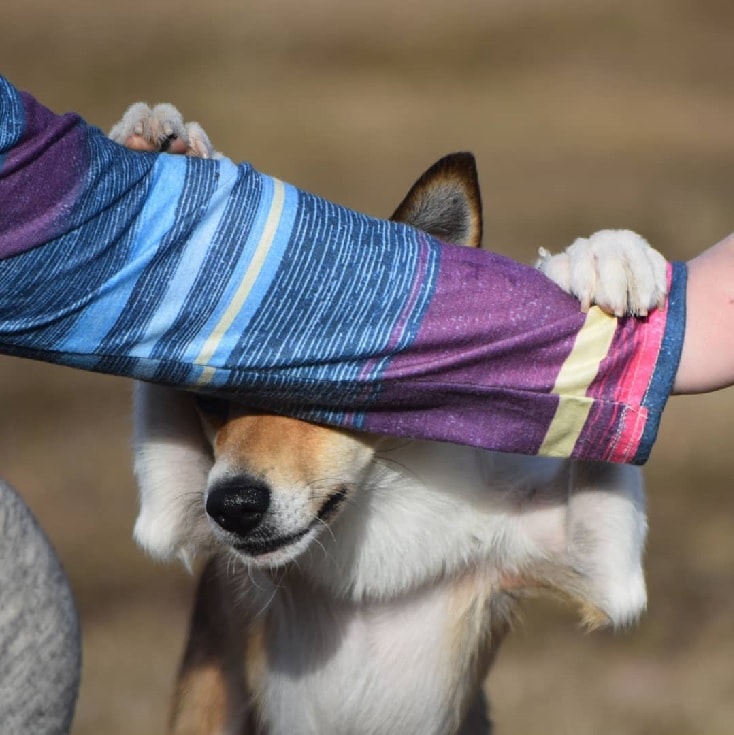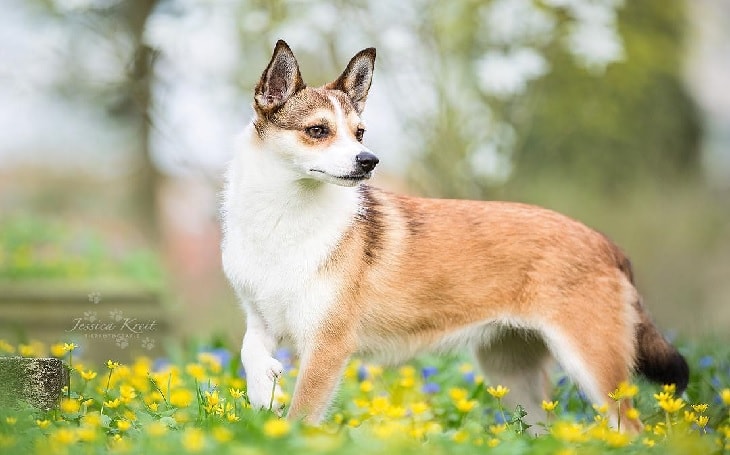Norwegian Lundehund Dog Breed Information
| Country of Origin | Norway |
| Nicknames and Other Names | Norwegian Puffin Dog Norsk Lundehund Lundehund |
| Scientific Name | Canis lupus familiaris |
| Breed Type | Purebred |
| Group | Non-Sporting Dog |
| Bred For | Hunting puffins and their eggs |
| Size | Medium-sized |
| Recognized By | UKC, FCI, AKC |
| Life Span | 12-15 years |
| Ideal Weight | 20-30 pounds (male and female) |
| Ideal Height | Male: 13-15 inches Female: 12-14 inches |
| Fur Type | Double coat, Harsh outer coat and soft, dense undercoat |
| Common Colors | Black, Reddish Brown, White, Gray, Yellow, Sable and White |
| Markings | Black markings, Gray markings, Black Tips, white markings |
| Availability | Rarely available |
| Achievements | None |
| Suitable for Apartments | Not Suitable |
| Used in World War | No |
| Most Similar To | Swedish Vallhund |
Norwegian Lundehunds
These Norwegian Lundehund are very protective and possessive towards their family, territory and their belongings. If you want to add a Norwegian Lundehund in your family then here are some information you must know about them.
History And Origin
Lundehund were developed in 1500 on the island of the northern and western coats of Norway. These breeds were bred to hunt puffin birds. In the 19th century hunting puffin birds became illegal when the birds were named as protected species. After that, the Norwegian Lundehund started declining in number.
Around the World War II, Norwegian Lundehund were almost extinct, therefore the breeders revived the breed. The American Kennel Club recognized the breed in 2011, and remains small in number.
Norwegian Lundehund And Kids
Norwegian Lundehund are good with children as they are energetic, they make a good companion with kids. They are playful, lively and protective as well.
Norwegian Lundehund love carrying their toys around everywhere they go. They will enjoy their playtime with their playmates running from one place to another. Kids who can teach them new tricks can be their best playmate.
These breeds, however, should not be trusted around kids every time. They may bark at kids and chase them when it feels irritated. Supervise your child and teach them not to snatch its toys and pull its tail.
Temperament And Personality Traits
Norwegian Lundehunds area very friendly dog breed but are quite reserved with strangers. With its own family, they are very out-going and lively. They are very protective which make them an excellent guard dogs.
These dogs are quite independent thinkers may tend to manipulate you. The Lundehund is not only observant but is hyper observant. It will let you know by barking if anyone approaches the territory.

Image Source- Instagram @team.mazayo.
Norwegian Lundehunds
These breed do best in homes with busy people around them to keep their mind stimulated. Norwegian Lundehund love to stay in pack with their loved ones. If left alone for longer periods, they may develop separation anxiety and become destructive and diggers.
Trainability
Training the Norwegian Lundehunds can be challenging. They are independent thinkers and have their mind of their own. They try to do everything on their own. It needs patience and consistency to train a Norwegian Lundehund.
If the leaders are not confident then the dog might take the position and rule the session. Norwegian Lundehunds are very tuned in every step you take. They should be sent to puppy school and obedience classes to help them socialize with other pets and people.
Facts About Norwegian Lundehund
- The Norwegian Lundehund have six toes which makes them unique among the dog breed.
- They can close their ears completely for protection and can also bend their head backward and touch the spine.
- When the farmers started catching puffin with nets, Lundehunds were almost extinct. In the other hand, the government started levying taxes on Lundehunds. Many owners couldn’t pay the taxes as a result they started declining.
Health Problems
| General Health | Healthy |
| Common Health Issues | Lundehund Syndrome, Hip Dysplasia |
| Hypoallergenic | No |
| Vaccination Required | Rabies, Kennel Cough, Canine Distemper, Canine Parvovirus, Canine Coronavirus, Leptospirosis, Canine Parainfluenza |
| Shedding | Moderate Shedder |
| Drooling | Low Drooler |
| Grooming | Average Grooming Required |
| Weight Gain Potential | Average |
| Separation Anxiety | High Chance |
| Allergies | None |
| Diets and Supplements | Protein: 23% Fat: 8% Glucosamine Antioxidants Fih Oil Probiotics |
Lundehund Syndrome: This condition affects most of the Norwegian Lundehund. It is a collective term for a group of intestinal disorders.
This is a major disease any Norwegian Lundehund can have. Other are same as all breed such as, canine hip dysplasia, cataracts, epilepsy and cancer. These kind of disease are common among the canine as they age gradually.
Price of Norwegian Lundehund Puppy
If you want to purchase a Norwegian Lundehund puppy then it will cost you somewhere around $400 – $600. The price of the breed depends upon the quality of the breed as well as the breeders.
Number Of Puppies
The Norwegian Lundehund gives birth to 4-8 puppies at a time.
Size Of Norwegian Lundehund
Height: The Norwegian Lundehund stands up to 12-15 inches tall which relatively makes them the small sized dogs.
Weight: The average weight of the Norwegian Lundehund is 13-20 pounds.
Color Patterns
Norwegian Lundehund are found in five colors.
- Black
- Gray
- Reddish Brown
- White
- Yellow
Breeds Similar To Norwegian Lundehund
- Swedish Vallhund
- Finnish Lapphund
- Icelandic Sheepdog
- Norbottenspets
- Norwegian Buhund
To conclude, Norwegian Lundehund are best suited for homes who can give them enough time and training. However, temperament and personality depends on how you raise them.
Visit Doglime For More Dog Breed Information.
Tags










